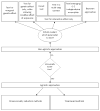Challenges and opportunities in genome-wide environmental interaction (GWEI) studies
- PMID: 22760307
- PMCID: PMC3677711
- DOI: 10.1007/s00439-012-1192-0
Challenges and opportunities in genome-wide environmental interaction (GWEI) studies
Abstract
The interest in performing gene-environment interaction studies has seen a significant increase with the increase of advanced molecular genetics techniques. Practically, it became possible to investigate the role of environmental factors in disease risk and hence to investigate their role as genetic effect modifiers. The understanding that genetics is important in the uptake and metabolism of toxic substances is an example of how genetic profiles can modify important environmental risk factors to disease. Several rationales exist to set up gene-environment interaction studies and the technical challenges related to these studies-when the number of environmental or genetic risk factors is relatively small-has been described before. In the post-genomic era, it is now possible to study thousands of genes and their interaction with the environment. This brings along a whole range of new challenges and opportunities. Despite a continuing effort in developing efficient methods and optimal bioinformatics infrastructures to deal with the available wealth of data, the challenge remains how to best present and analyze genome-wide environmental interaction (GWEI) studies involving multiple genetic and environmental factors. Since GWEIs are performed at the intersection of statistical genetics, bioinformatics and epidemiology, usually similar problems need to be dealt with as for genome-wide association gene-gene interaction studies. However, additional complexities need to be considered which are typical for large-scale epidemiological studies, but are also related to "joining" two heterogeneous types of data in explaining complex disease trait variation or for prediction purposes.
Conflict of interest statement
The authors declare that they have no conflict of interest.
Figures


References
-
- Albert PS, Ratnasinghe D, Tangrea J, Wacholder S. Limitations of the case-only design for identifying gene-environment interactions. Am J Epidemiol. 2001;154:687–93. - PubMed
-
- Andrieu N, Goldstein AM. The case-combined-control design was efficient in detecting gene-environment interactions. J Clin Epidemiol. 2004;57:662–71. - PubMed

